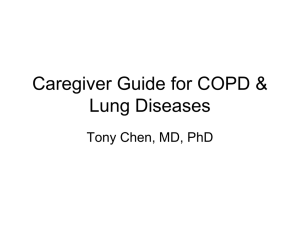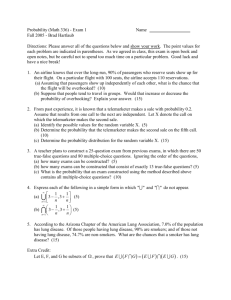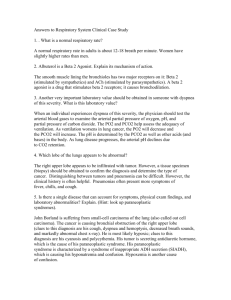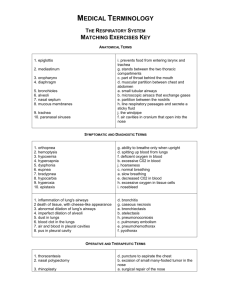Materials: String for measuring, ruler, round
advertisement
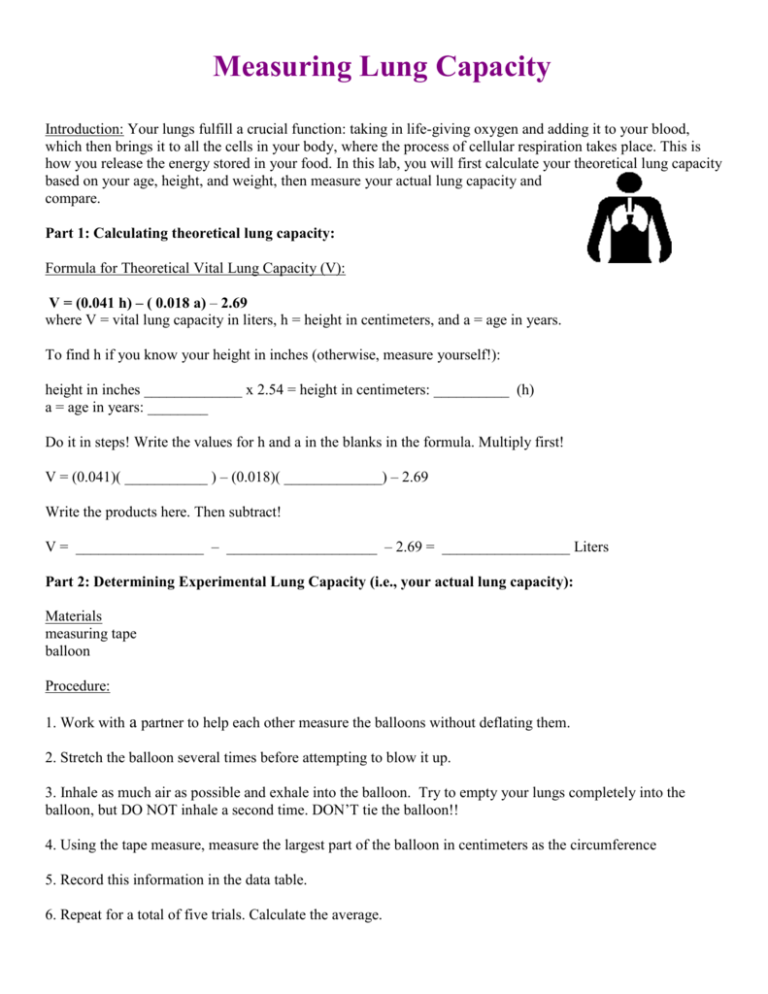
Measuring Lung Capacity Introduction: Your lungs fulfill a crucial function: taking in life-giving oxygen and adding it to your blood, which then brings it to all the cells in your body, where the process of cellular respiration takes place. This is how you release the energy stored in your food. In this lab, you will first calculate your theoretical lung capacity based on your age, height, and weight, then measure your actual lung capacity and compare. Part 1: Calculating theoretical lung capacity: Formula for Theoretical Vital Lung Capacity (V): V = (0.041 h) – ( 0.018 a) – 2.69 where V = vital lung capacity in liters, h = height in centimeters, and a = age in years. To find h if you know your height in inches (otherwise, measure yourself!): height in inches _____________ x 2.54 = height in centimeters: __________ (h) a = age in years: ________ Do it in steps! Write the values for h and a in the blanks in the formula. Multiply first! V = (0.041)( ___________ ) – (0.018)( _____________) – 2.69 Write the products here. Then subtract! V = _________________ – ____________________ – 2.69 = _________________ Liters Part 2: Determining Experimental Lung Capacity (i.e., your actual lung capacity): Materials measuring tape balloon Procedure: 1. Work with a partner to help each other measure the balloons without deflating them. 2. Stretch the balloon several times before attempting to blow it up. 3. Inhale as much air as possible and exhale into the balloon. Try to empty your lungs completely into the balloon, but DO NOT inhale a second time. DON’T tie the balloon!! 4. Using the tape measure, measure the largest part of the balloon in centimeters as the circumference 5. Record this information in the data table. 6. Repeat for a total of five trials. Calculate the average. Data Table (Copy into Journal.) Circumference of the balloon (centimeters) Trial 1 Trial 2 Trail 3 Trial 4 Trial 5 Average 7. Using the formula for Circumference and your average circumference, find the radius. In other words, solve the formula for r. (Show your work.) Since C = 2 r, then r = C/2 (radius equals average Circumference divided by 6.28) radius = _____________ cm 8. Calculate the VOLUME of the balloon (it is close enough to a sphere). Your answer will be in cubic centimeters (cc), which is equivalent to milliliters (mL). This is your experimental (or actual) lung capacity. (Show your work.) Volume = 4/3 r3 (Cube the radius first! If using a calculator, think of it this way: Volume equals radius cubed times pi times four divided by three) Volume = ____________ cc (or mL) Recall that 1 cc = 1 milliliter (mL) 1000 mL= 1 Liter, so divide your answer in mL by 1000 to get your Lung capacity in Liters: ______________ mL ÷ 1000 = ________________ Liters Analysis: Answer in your Journal in complete sentences that can be understood without knowing the question. 1. Why did we perform multiple trials? 2. Compare your theoretical lung capacity compare to your actual lung capacity. 3. If your experimental lung capacity is significantly different than your theoretical lung capacity, what factors do you think could account for this difference? 4. Do you think athletes or non-athletes would have a higher lung capacity? Would the type of sport played have any effect on lung capacity? 5. What about comparing the lung capacity of smokers and non-smokers? Do you think there would be a difference? Explain. 6. Formulate a hypothesis about lung capacity in different groups of people, those mentioned or something you come up with. Write your hypothesis and explain how you would test it.



